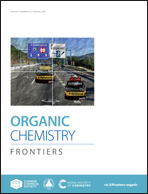Synchronous and basic asynchronous hydrogen-atom abstraction of benzylic substrates by high-valent iron–oxo porphyrin species†
Abstract
The relationship between the activation free energy and bond dissociation energy (BDE) as well as the pKa of a variety of compounds (a1–a15 and b1–b15) in benzylic C–H hydroxylation by iron–oxo porphyrin species (Cat1–Cat4) has been explored with density functional theory (DFT) calculations. The hydrogen-atom transfer (HAT) step was found to be the rate-determining step in this process. The computational results show that there is a relatively good linear correlation between the activation free energy of the HAT step and the BDE of the benzylic substrate (a1–a15) in the systems of Cat1 (model Cpd I with an axial chloride ligand) and Cat2 (which contains electron-donating substituents at the meso-position of the porphyrin). Conversely, when studying the reaction of Cat2 with benzylic substrates (b1–b15) bearing a para-substituted electron-withdrawing group, a relatively strong linear correlation between the activation free energy and the pKa of the substrate was observed. This linear correlation between the activation free energy and the pKa of substrates (b1–b15) is further enhanced when employing Cat4, which represents the one-electron reduced form of Cat2. Natural population analysis (NPA) and localized molecular orbital (LMO) analysis illustrated that the two distinct linear correlations observed between the activation free energy and either BDE or pKa in benzylic C–H hydroxylation can be attributed to different mechanisms of the HAT step. These mechanisms can be distinguished as either a synchronous HAT mechanism or a basic asynchronous HAT mechanism where proton transfer occurs faster than electron transfer. The findings presented here suggest promising opportunities for advancing metalloporphyrin-catalyzed C–H hydroxylation reactions.



 Please wait while we load your content...
Please wait while we load your content...